Sony PCG-FX310, PCG-FX310P, PCG-FX340, PCG-FX340P, PCG-FX370 User Guide
...
Welcome....................................................... |
7 |
Using Your VAIO Notebook........................ |
9 |
Using the Keyboard................................................... |
10 |
Functions of the keyboard keys ......................................... |
11 |
Combinations and functions with the Windows key ......... |
12 |
Indicators ........................................................................... |
13 |
Indicator lights ................................................................... |
14 |
Combinations and functions with the Fn key .................... |
15 |
Using the Touchpad .................................................. |
17 |
Using the Floppy Disk Drive .................................... |
19 |
To insert a floppy disk ....................................................... |
19 |
To remove a floppy disk .................................................... |
20 |
To remove the floppy disk drive........................................ |
20 |
To reinsert the floppy disk drive........................................ |
21 |
Using the Optical Disc Drive .................................... |
23 |
To insert a disc ................................................................... |
23 |
To remove a disc................................................................ |
24 |
To play a DVD................................................................... |
25 |
To play an audio CD .......................................................... |
26 |
Notes on CD and DVD media ........................................... |
27 |
To write data to a CD-RW or CD-R disc........................... |
28 |
Using PC Cards ......................................................... |
29 |
To insert a PC card............................................................. |
29 |
To remove a PC Card......................................................... |
31 |
Notes on PC Cards ............................................................. |
32 |
Using a Second Battery Pack .................................... |
33 |
To insert a second battery pack.......................................... |
33 |
To charge the second battery pack..................................... |
34 |
To remove the second battery pack ................................... |
35 |
1

Change text in this variable definition to document title. |
|
Using the Weight Saver ............................................ |
37 |
To attach the weight saver ................................................ |
37 |
To remove the weight saver .............................................. |
38 |
Using Power Saving Modes...................................... |
39 |
Normal mode..................................................................... |
39 |
Standby mode.................................................................... |
39 |
Hibernate mode ................................................................. |
39 |
Notes on power saving modes .......................................... |
40 |
Connecting a Phone Line .......................................... |
41 |
Connecting to a LAN ................................................ |
42 |
To set up your ethernet connection ................................... |
42 |
Connecting Peripheral Devices ............... |
45 |
Connecting a Port Replicator .................................... |
46 |
To attach your notebook to the port replicator.................. |
46 |
To remove your notebook from the port replicator........... |
49 |
Connecting an External Mouse or Keyboard............ |
50 |
To connect an external mouse or keyboard ...................... |
50 |
Connecting a Parallel Port Printer ............................ |
51 |
To connect a printer .......................................................... |
51 |
Connecting a USB Printer......................................... |
52 |
To connect a USB printer.................................................. |
52 |
Connecting an External Display ............................... |
53 |
To connect a computer display ......................................... |
53 |
To connect a multimedia computer display ...................... |
53 |
To connect a projector....................................................... |
54 |
To select a display............................................................. |
55 |
2

Connecting a TV Display .......................................... |
56 |
To connect a TV ................................................................ |
56 |
Changing the display resolution for TV Out ..................... |
56 |
Notes on TV display .......................................................... |
57 |
Connecting a USB Device......................................... |
58 |
To connect a USB device................................................... |
58 |
Connecting an i.LINK Device................................... |
59 |
To connect a digital video camera recorder ....................... |
60 |
Notes on i.LINK devices ................................................... |
60 |
Connecting VAIO computers.................................... |
62 |
Connecting with i.LINK .................................................... |
62 |
Connecting External Speakers .................................. |
63 |
Before connecting your external speakers ......................... |
63 |
To connect external speakers ............................................. |
63 |
Connecting an External Microphone......................... |
64 |
To connect an external microphone................................... |
64 |
Expanding Your Notebook Capabilities ................... |
65 |
Personal Digital Assistant .................................................. |
65 |
Wireless LAN Access Point .............................................. |
65 |
Wireless LAN PC Card...................................................... |
66 |
Customizing Your VAIO Notebook .......... |
67 |
Displaying the Sony Notebook Setup Screen ........... |
68 |
To display the Sony Notebook Setup screen ..................... |
68 |
Sony Notebook Setup Tabs................................................ |
69 |
Controlling Power Management ............................... |
70 |
To view the Power Management status icons.................... |
70 |
Power Management profiles .............................................. |
71 |
Power management commands ......................................... |
74 |
Conserving battery power .................................................. |
74 |
3

Change text in this variable definition to document title. |
|
Displaying Battery Information ................................ |
75 |
To activate the Battery Information toolbar...................... |
75 |
Battery icon descriptions................................................... |
75 |
To display detailed battery information ............................ |
76 |
To customize the Battery Information toolbar and alarm sys- |
|
tem..................................................................................... |
77 |
Selecting the Display Mode ...................................... |
78 |
To select the display mode................................................ |
78 |
To change the Window Design of Sony software............. |
79 |
Adding Memory to Your VAIO Notebook 81
Precautions and Procedures ...................................... |
82 |
Typical expansion memory configuration ........................ |
82 |
Removing a Memory Module................................... |
84 |
Installing a Memory Module .................................... |
86 |
Viewing the Amount of Memory.............................. |
88 |
About the Software on Your Notebook ...89
Software Overview ................................................... |
90 |
Application, Driver, and System Recovery CDs ...... |
96 |
Using Your Recovery CDs ....................................... |
97 |
To use the Application Recovery CD(s) ........................... |
97 |
To use the Driver Recovery CD(s) ................................... |
97 |
To use the System Recovery CD(s) ................................ |
101 |
4

Troubleshooting ...................................... |
105 |
|
Troubleshooting Your Notebook ............................ |
|
106 |
My notebook does not start.............................................. |
|
106 |
My notebook starts, but a BIOS error is displayed.......... |
|
106 |
My notebook starts, but the message “Operating system not |
||
found” appears and Windows does not start.................... |
|
107 |
My notebook stops responding or does not shut down.... |
|
108 |
The Power Management setting is not responding. ......... |
|
108 |
The sound of my notebook’s fan is too loud. .................. |
|
109 |
Why does the System Properties dialog box display a slower |
||
CPU speed than advertised? ............................................ |
|
109 |
Troubleshooting the LCD Screen............................ |
|
110 |
My LCD screen is blank. ................................................. |
|
110 |
My LCD screen continues to show the previous screen. |
.110 |
|
The image on my connected external display is not centered |
||
or sized properly. ............................................................. |
|
110 |
I want to change the video resolution of my display. ...... |
|
110 |
I want to change the display resolution for TV Out ........ |
|
110 |
I cannot switch the LCD display to TV, and vice versa |
. . |
111 |
Troubleshooting the Mouse and Touchpad ............. |
|
112 |
My mouse does not work................................................. |
|
112 |
My touchpad does not work properly. ............................. |
|
112 |
The pointer does not move while I am using the Touchpad or |
||
Mouse............................................................................... |
|
113 |
Troubleshooting Drives, PC Cards and Peripheral De- |
||
vices......................................................................... |
|
114 |
My floppy disk drive cannot write to a floppy disk......... |
|
114 |
My optical drive is not playing a CD or DVD properly. . |
114 |
|
My optical drive tray does not open. ............................... |
|
115 |
I cannot use Digital Video (DV) devices. The message “DV |
||
equipment seems to be disconnected or turned off” appears. |
||
5

Change text in this variable definition to document title. |
|
115 |
|
My PC Card is not working. ........................................... |
115 |
Troubleshooting Software....................................... |
116 |
My software program stops responding or crashes......... |
116 |
When I click an application icon, the message “You must in- |
|
sert the application CD into your optical drive” appears and |
|
the software does not start............................................... |
116 |
I cannot use the DVgate software. .................................. |
116 |
My computer’s start-up time seems longer after I have in- |
|
stalled AOL. What can I do?........................................... |
116 |
Troubleshooting the Modem................................... |
118 |
My modem does not work. ............................................. |
118 |
My modem connection is slow. ...................................... |
118 |
Troubleshooting Audio ........................................... |
119 |
My speakers make no sound. .......................................... |
119 |
My microphone does not work. ...................................... |
119 |
Troubleshooting the Printer .................................... |
120 |
I cannot print. .................................................................. |
120 |
Troubleshooting i.LINK devices ............................ |
121 |
I cannot establish a connection between two VAIO comput- |
|
ers when using an i.LINK cable...................................... |
121 |
Getting Help............................................. |
123 |
Support Options ...................................................... |
124 |
Software Support Information ................................ |
126 |
Sony Service Center................................................ |
128 |
Index......................................................... |
129 |
6

Welcome
Congratulations on your purchase of this Sony VAIO® computer, and welcome to the VAIO Notebook User Guide.
This User Guide provides detailed information on all aspects of using your new VAIO computer, from keyboard functions to preinstalled software applications.
In the left navigation window, click the topics you want to learn more about, and that information will be displayed in this main window.
7

Change text in this variable definition to document title.
8

Using Your VAIO Notebook
This section describes the following aspects of your new computer:
Using the Keyboard
Using the Touchpad
Using the Floppy Disk Drive
Using the Optical Disc Drive
Using PC Cards
Using a Second Battery Pack
Using the Weight Saver
Using Power Saving Modes
Connecting a Phone Line
Connecting to a LAN
9
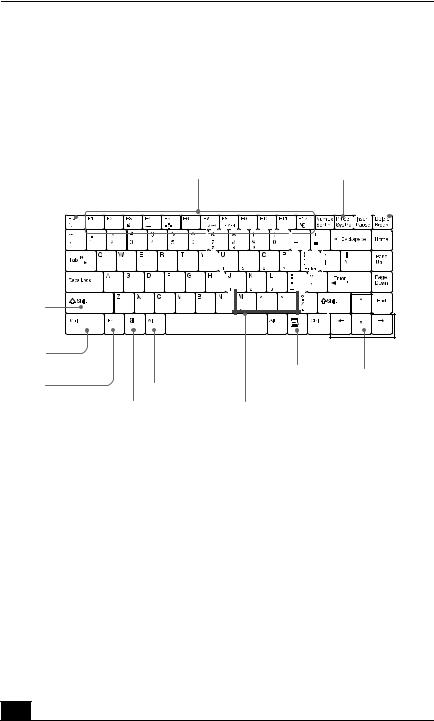
Change text in this variable definition to document title.
Using the Keyboard
Your keyboard is very similar to a typewriter’s, but the keyboard has additional keys that perform specific computer-related tasks.
Keyboard
|
|
|
|
|
|
|
|
|
|
|
|
|
|
|
Correction |
||
Escape key |
Function keys |
Print Screen key keys |
|||||||||||||||
|
|
|
|
|
|
|
|
|
|
|
|
|
|
|
|
|
|
|
|
|
|
|
|
|
|
|
|
|
|
|
|
|
|
|
|
|
|
|
|
|
|
|
|
|
|
|
|
|
|
|
|
|
|
|
|
|
|
|
|
|
|
|
|
|
|
|
|
|
|
|
|
|
|
|
|
|
|
|
|
|
|
|
|
|
|
|
|
|
|
|
|
|
|
|
|
|
|
|
|
|
|
|
|
|
|
|
|
Shift |
|
|
key |
|
|
Ctrl key |
|
|
|
|
Applications key Navigation |
Fn key |
Alt key |
keys |
|
Windows® key |
Numeric keypad area |
10

|
Using the Keyboard |
Functions of the keyboard keys |
|
|
|
Key |
Description |
|
|
Numeric keypad |
Contains the keys found on a typical calculator. Use the |
area |
numeric keypad area to type numbers or to perform |
|
mathematical calculations such as addition and subtraction. |
|
Note that you must press the Num Lock key to activate the |
|
numeric keypad. (When you do so, the Num Lock light will |
|
be on.) |
|
|
Navigation keys |
Several keys are devoted to moving the cursor on the screen. |
|
|
Correction keys |
The Insert, Back Space, and Delete keys enable you to make |
|
corrections in your documents. |
|
|
Function keys |
The twelve function keys along the top of the keyboard are |
|
used to perform designated tasks. For example, in many |
|
applications, F1 is the Help key. The task associated with |
|
each function key may vary from one application to the next. |
|
|
Escape key |
The Esc (Escape) key is used to cancel commands. |
|
|
Print Screen key |
The Print Screen key takes an electronic snapshot of the |
|
screen and places it in the Windows® Clipboard. You can |
|
then paste the screen shot into a document and print it. |
|
|
Operator keys |
Several keys are always used with at least one other key: Ctrl, |
(Shift, Ctrl, |
Alt, and Shift. When held down with another key, the Ctrl |
Alt keys) |
(Control) and Alt (Alternate) keys offer another way to give |
|
commands. For example, in many applications, instead of |
|
choosing the Save command from a menu, you can hold |
down Ctrl and press S (referred to as Ctrl+S). The Shift key operates the same way as on a typewriter; it is used to produce capital letters or special symbols, such as @ and $.
11
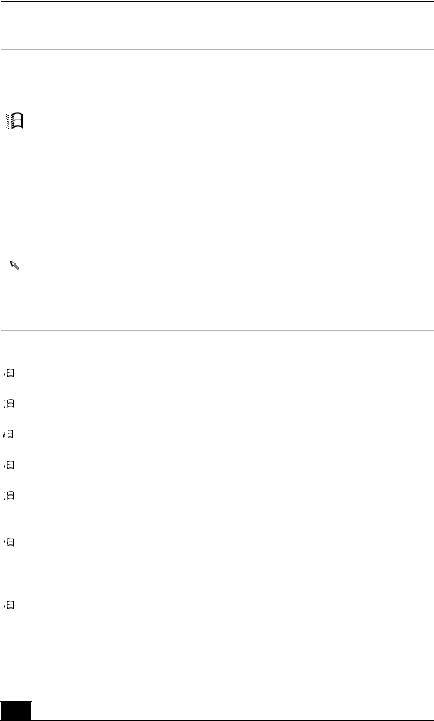
Change text in this variable definition to document title.
Key |
Description |
||
|
|
|
|
Windows key |
The key with the Windows® logo displays the Windows Start |
||
|
|
|
menu; it is the equivalent of clicking the Start button on the |
|
|
|
taskbar. See “Combinations and functions with the Windows |
|
|
|
|
|
|
|
key” for more information. |
|
|
|
|
Fn key |
The Fn key is used in combination with other keys to issue |
||
|
|
|
commands. See “Combinations and functions with the Fn |
|
|
|
key” for more information. |
|
|
|
|
Applications key |
The Applications key displays a shortcut menu of context- |
||
|
|
|
sensitive choices. Pressing this key is the equivalent of |
|
|
|
clicking the right mouse button. |
|
|
|
|
|
|
|
|
|
|
|
|
|
|
|
|
|
|
|
|
Combinations and functions with the Windows key
Combination |
Function |
|
|
|
|
|
+ F1 |
Displays VAIO® Help and Support Center. |
|
||
|
||
|
|
|
|
+ Tab |
Switches the selected button on the taskbar. |
|
||
|
||
|
|
|
|
+ D |
Displays the Desktop. |
|
||
|
||
|
|
|
|
+ E |
Displays Windows Explorer. |
|
||
|
||
|
|
|
|
+ F |
Displays the Search window to find a file or folder. This is |
|
||
|
||
|
|
the equivalent of selecting Search from the Start menu. |
|
|
|
|
+ Ctrl + F |
Displays the Search Results: Computers window where you |
|
||
|
||
|
|
can locate other computers. This is the equivalent of selecting |
|
|
Search and then Computers from the Start menu. |
|
|
|
|
+ M |
Minimizes all displayed windows. |
|
||
|
||
|
|
|
12
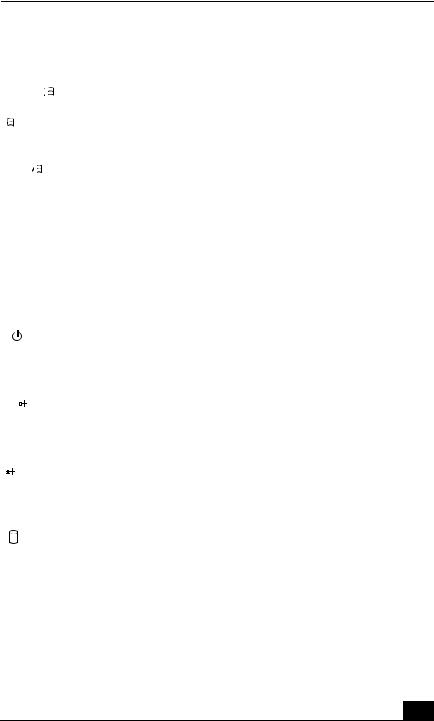
|
|
|
|
|
|
|
|
Using the Keyboard |
|
|
|
|
|
|
|
|
|
Combination |
Function |
|||||||
|
|
|
|
|
|
|
|
|
Shift + |
|
+ M |
Returns all minimized windows to their previous size. |
|||||
|
||||||||
|
||||||||
|
|
|
|
|
|
|
|
|
|
+ R |
|
|
Displays the Run window. This is the equivalent of selecting |
||||
|
|
|
||||||
|
|
|
||||||
|
|
|
|
|
|
|
|
Run from the Start menu. |
|
|
|
|
|
|
|
|
|
Fn + |
|
|
+ Insert |
Displays the System Properties window. This is the |
||||
|
||||||||
|
||||||||
|
|
|
|
|
|
|
|
equivalent of selecting Control Panel and then System from |
|
|
|
|
|
|
|
|
the Start menu. |
|
|
|
|
|
|
|
|
|
Indicators |
|
|||||||
|
|
|
|
|
|
|
|
|
Indicator |
Function |
|||||||
|
|
|
|
|
|
|
|
|
Power |
|
|
Light is green when the power to the notebook is turned on, |
|||||
|
|
|
|
|
|
|
|
flashes amber in Standby mode, and turns off when the |
|
|
|
|
|
|
|
|
notebook is in Hibernate mode or powered off. |
|
|
|
|
|
|
|
|
|
Battery 1 |
Indicates the status of the battery inserted in the battery bay |
|||||||
|
|
|
|
|
|
|
|
on the left side of the notebook. |
1 |
|
|
|
|
|
|
|
|
|
|
|
|
|
|
|
||
|
|
|
|
|
|
|
|
|
Battery 2 |
Indicates the status of the battery inserted in the multipurpose |
|||||||
|
|
|
|
|
|
|
|
drive bay on the right side of the notebook. |
|
|
2 |
|
|
|
|
|
|
|
|
|
|
|
|
|
|
|
|
|
|
|
|
|
|
|
|
Hard disk |
Lights when data is being read from or written to the hard |
|||||||
|
|
|
|
|
|
|
|
drive. Do not enter Standby mode or turn off the notebook |
|
|
|
|
|
|
|
|
when this indicator light is on. |
|
|
|
|
|
|
|
|
|
13

Change text in this variable definition to document title.
Indicator lights
Light |
On |
Off |
|
|
|
Num |
The number keys in the numeric |
The alphanumeric character keys |
Lock |
keypad are active. |
in the keypad area are active. |
|
|
|
Caps |
The letters appear in uppercase as you Letters appear in lower case as |
|
Lock |
type. The Shift key lowers the case of you type (unless you hold down |
|
|
typed letters when Caps Lock is on. the Shift key). |
|
|
|
|
Scroll |
The screen scrolls differently. |
Information moves across the |
Lock |
(Exactly how it scrolls depends on the display normally. |
|
|
specific application. It has no effect in |
|
|
many applications.) |
|
|
|
|
14
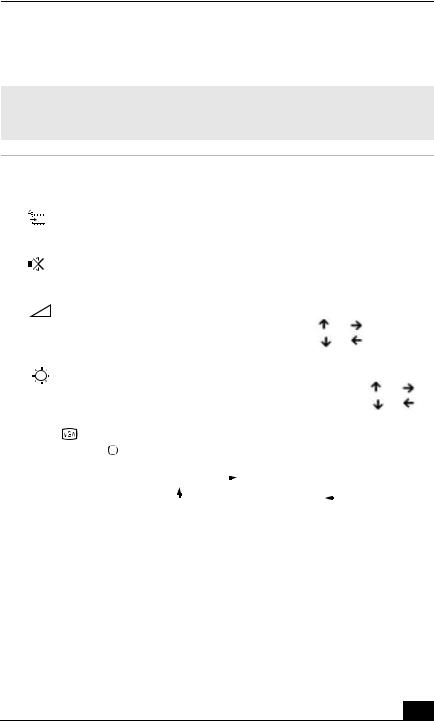
Using the Keyboard
Combinations and functions with the Fn key
If you switch user identities during a computing session, the Fn+F7 and Fn+F8 key functionality (if available on your computer) will be interrupted. To switch to an external display or monitor, see “Selecting the Display Mode” for more information.
Combinations/ |
|
|
|
|
|
|
|
|
||
Feature |
Function |
|
|
|
|
|
|
|||
|
|
|
|
|
|
|
|
|
||
Fn+ |
(ESC) |
Puts the system into Standby mode, a power management |
||||||||
Standby |
state. To return the system to the active state, press any key. |
|||||||||
|
|
|
|
|
|
|
|
|
|
|
Fn+ |
(F3) |
Toggles the built-in speaker off and on. |
|
|
|
|||||
Mute On/Off |
|
|
|
|
|
|
|
|
||
|
|
|
|
|
|
|
|
|
|
|
Fn+ |
|
(F4) |
Adjusts the built-in speaker volume. |
|
|
|
||||
Speaker volume |
To increase volume, press Fn+F4, then |
or . |
|
|||||||
|
|
|
To decrease volume, press Fn+F4, then |
or . |
|
|||||
|
|
|
|
|
|
|
|
|
|
|
Fn+ |
(F5) |
Adjusts the brightness of the LCD. |
|
|
|
|||||
Brightness control |
To increase light intensity, press Fn+F5 and then |
or . |
||||||||
|
|
|
To decrease light intensity, press Fn+F5 and then |
or . |
||||||
|
|
|
|
|
|
|
|
|
||
Fn+ |
|
|
Toggles through the LCD, external display (connected to the |
|||||||
LCD |
/ |
|||||||||
(F7) |
|
|
Monitor port) and both LCD and external display. |
|||||||
Switch to the |
Only LCD |
|
|
LCD and external display |
|
|
||||
external |
|
|
|
|
||||||
|
|
|
|
|||||||
monitor/LCD |
|
|
|
Only external display |
|
|
|
|||
|
|
|
|
|
|
|||||
|
|
|
|
|
|
|
|
|
|
|
15
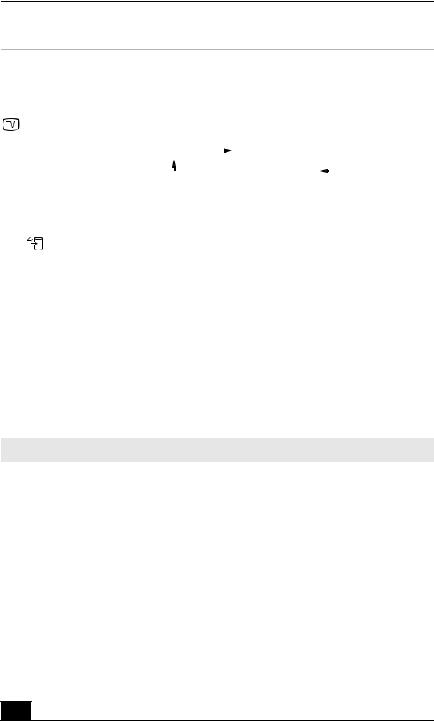
Change text in this variable definition to document title.
Combinations/ |
|
|
|
|
|
|
|
|
|||
Feature |
Function |
|
|
|
|
|
|
||||
|
|
|
|
|
|
|
|
|
|
|
|
Fn+ |
|
|
only/ |
Toggles between LCD-only and dual LCD/TV display |
|||||||
|
LCD |
||||||||||
|
(F8) |
modes. |
|
|
|
|
|
|
|||
Control TV Out |
Only LCD |
|
|
LCD and external display |
|
|
|||||
|
|
|
|
|
|
|
|
||||
|
|
|
|
|
|
|
|||||
|
|
|
|
|
|
|
Only external display |
|
|
||
|
|
|
|
|
|
|
|
|
|||
|
|
|
|
Connect the cable before you turn on the notebook, otherwise |
|||||||
|
|
|
|
Fn + F8 will not work. |
|||||||
|
|
|
|
|
|
|
|
|
|
|
|
Fn+ |
|
(F12) |
Provides for the lowest level of power consumption. |
||||||||
Hibernate |
When you execute this command, the state of the system and |
||||||||||
|
|
|
|
state of the peripheral devices are written to the hard disk and |
|||||||
|
|
|
|
the system power is turned off. To return the system to its |
|||||||
|
|
|
|
original state, use the power button to turn on power. |
|||||||
|
|
|
|
|
|
|
|
|
|
||
Fn+ F |
Display control. Minimizes and maximizes the LCD screen. |
||||||||||
|
|
|
|
If the default display resolution is reduced, this function |
|||||||
|
|
|
|
maximizes the display resolution to fit the screen size. |
|||||||
|
|
|
|
Maximizing the display screen enables you to view the |
|||||||
|
|
|
|
display at a greater resolution. |
|||||||
|
|
|
|
|
|
|
|
|
|
|
|
Some functions are not available until Windows® launches.
16
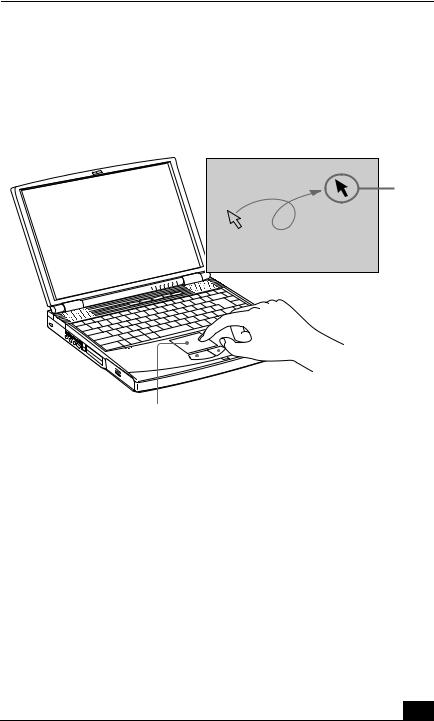
Using the Touchpad
Using the Touchpad
The keyboard contains a cursor-pointing device called a touchpad. You can point to, select, drag, and scroll objects on the screen using the built-in touchpad.
Touchpad
Pointer
|
Touchpad |
|
|
|
|
|
|
|
Right button |
||
|
|
|
|
|
Left button |
||
|
|
|
|
Action |
Description |
||
|
|
|
|
Point |
Slide one finger on the touchpad to place the pointer on an |
||
|
item or object. |
||
|
|
|
|
Click |
Press the left button once. |
||
|
|
|
|
Double-click |
Press the left button twice. |
||
|
|
|
|
17

Change text in this variable definition to document title.
Action |
Description |
|
|
Right-click |
Press the right button once. In many applications, this action |
|
displays a shortcut menu of context-sensitive choices. |
|
|
Drag |
Slide one finger while pressing the left button. |
|
|
Scroll |
Move your finger along the right edge of the touchpad to |
|
scroll vertically. Move your finger along the bottom to scroll |
|
horizontally. (The scroll function is available only with |
|
applications that support a touchpad scroll feature.) |
|
|
See Mouse Properties for information on touchpad features, such as clicking both buttons simultaneously, adjusting touchpad speed, and Easy Launcher functions. To access Mouse Properties, go to Start, select Control Panel, and click the Mouse icon.
18
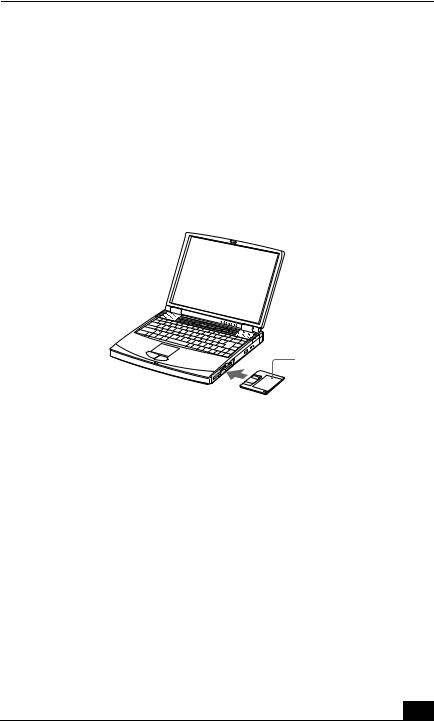
Using the Floppy Disk Drive
Using the Floppy Disk Drive
Your notebook is supplied with the floppy disk drive in the multipurpose bay.
To insert a floppy disk
1Hold the floppy disk with the label side facing up.
2Gently push the floppy disk into the drive until it clicks into place.
Inserting a floppy disk
Floppy disk
Floppy disk drive 
19
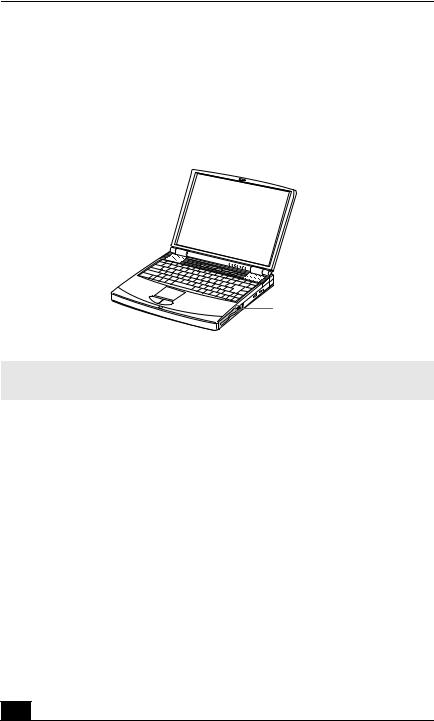
Change text in this variable definition to document title.
To remove a floppy disk
1After you finish using the floppy disk, wait until the LED indicator turns off.
2Press the Eject button to remove the floppy disk.
Removing a floppy disk
Eject button |
 LED indicator
LED indicator
Do not push the eject button when the LED indicator is turned on. Otherwise, data may be lost.
To remove the floppy disk drive
1Turn off the notebook.
2Locate the release lever on the bottom of the notebook.
20
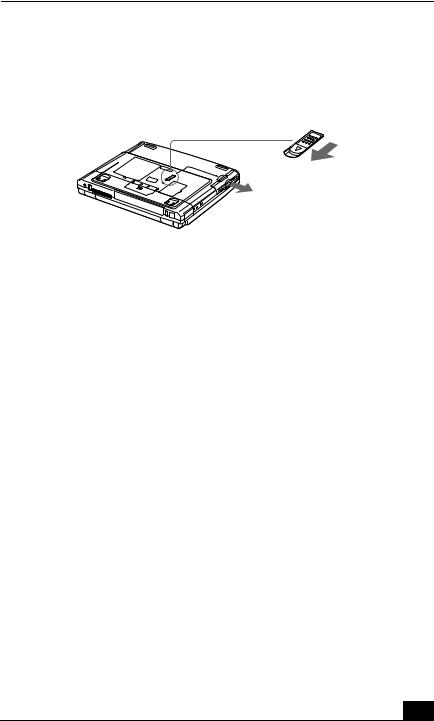
Using the Floppy Disk Drive
3 Slide the lever in the direction of the arrow.
Multipurpose bay release lever
Multipurpose bay release lever
4Slide the floppy disk drive out of the multipurpose bay.
5Insert the weight saver. See “Using the Weight Saver” for more information.
To reinsert the floppy disk drive
1Turn off the notebook.
2If another device is in the multipurpose bay, remove the device. See “To remove the second battery pack” for more information.
3Insert the floppy disk drive into the multipurpose bay with the VAIO label facing up.
21
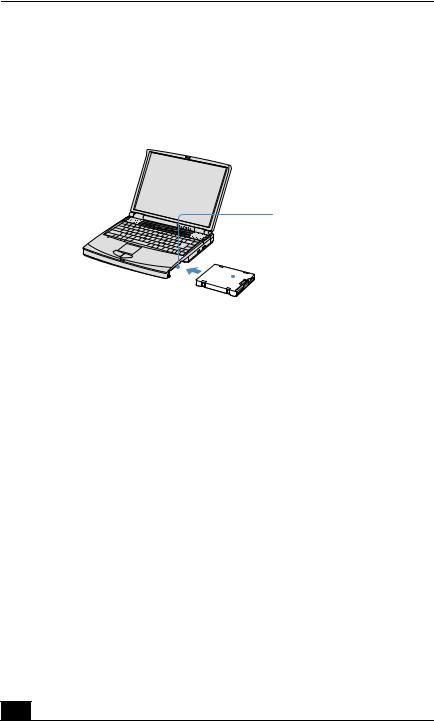
Change text in this variable definition to document title.
4Continue pushing the drive into the bay until the release lever locks into place.
Inserting the floppy disk drive
Multipurpose bay
 Floppy disk drive
Floppy disk drive
22

Using the Optical Disc Drive
Using the Optical Disc Drive
Your notebook comes with an optical disc drive, either a CD-RW/DVD Combo Drive or DVD-ROM drive, depending on the model you purchased.
Do not use adhesive labels to identify your discs. Adhesive labels may come off while the disc is in use in the optical drive, and may cause damage to the drive.
To insert a disc
When the notebook is in Standby or Hibernate mode, you cannot insert a disc. See “Controlling Power Management” for more information on Standby and Hibernate modes.
1Turn on the notebook.
2Press the Eject button to open the optical drive. The tray slides out.
Ejecting the tray
Eject button
3Place an optical disc on the tray with the label side facing up. For DVDs that can be played on both sides, the side of the disc facing up is the side that plays.
23
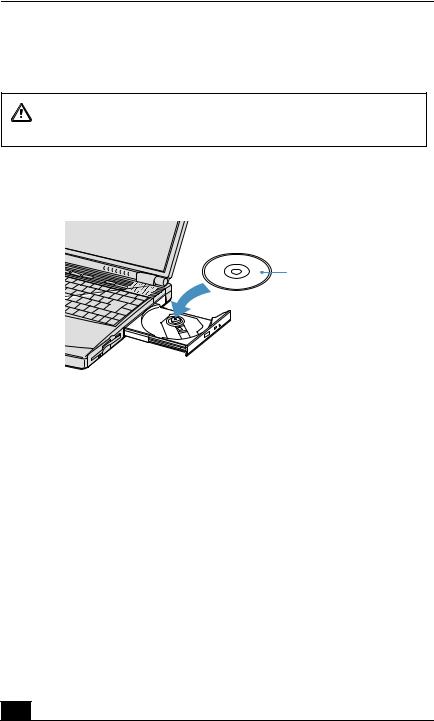
Change text in this variable definition to document title.
4 Push the disc onto the hub until the disc clicks securely into place.
Be sure to seat the disc firmly over the hub fingers. If you do not seat the disc firmly, you could damage the optical drive and you may not be able to open the tray.
Inserting an optical disc
Label side facing up
5 Close the tray by pushing it gently.
To remove a disc
When the notebook is in power saving modes, you cannot remove a disc. See “Controlling Power Management” for more information about power saving modes.
1After you finish using a disc, wait until the LED indicator turns off.
2Press the Eject button to remove the disc.
24
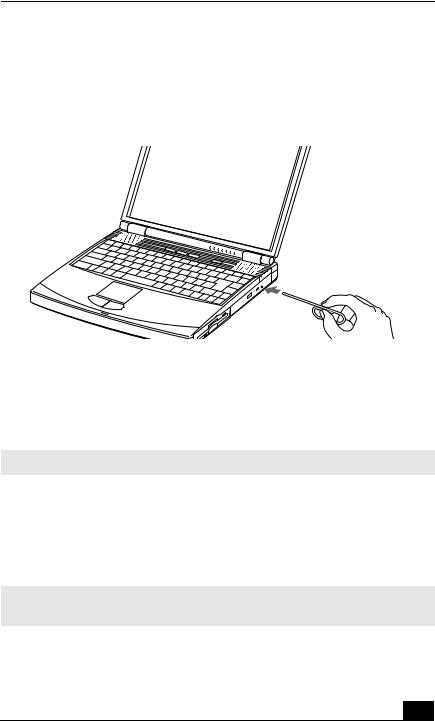
Using the Optical Disc Drive
3If the disc does not come out when you press the Eject button, turn off the notebook and insert a thin, straight object (such as a paper clip) into the manual eject hole.
Manually removing a disc
To play a DVD
To play a DVD, you may use the optical disc drive and the preinstalled WinDVD® software. For more information on WinDVD, see the Help menu in the WinDVD application.
Before you use the optical disc drive to play a DVD, quit any open applications.
Your optical disc drive can read most DVD-R media. When you are ready to play a DVD, read the suggestions below to maximize your video viewing experience.
When playing a DVD on battery power, set the power management profile to DVD. You can also set the power management profile to Automatic Profile Selection if the display is not clear when using other profiles.
Automatic Profile Selection sets the power management profile to DVD whenever a DVD is inserted. See “Controlling Power Management” for more information.
If you connect your notebook to a TV display, you may need to adjust the display resolution. Read the suggestions below to set the display resolution
25

Change text in this variable definition to document title.
to the proper dimensions. Also see “Selecting the Display Mode” for more information.
If the notebook is set to the default display setting, part of the video screen will not appear. To view the entire screen, adjust the display resolution to 640 x 480. See “Connecting a TV Display” for more information.
The screen resolution must be set to 640 x 480 dots in order to play a DVD while using the TV Out jack. See “Connecting a TV Display” for more information.
Some discs recorded at 20 or 24 bits may produce noise while playing. If you have audio devices connected, this may cause damage to your hearing and the speakers. Reduce the volume before playing a DVD.
You cannot use the Fn + F8 function to switch between LCD and TV once a DVD is inserted into the optical drive.
Do not switch between LCD and the external display while the DVD is playing. This may cause a malfunction, and you may need to restart the DVD software.
To play an audio CD
To play an audio CD, make sure the audio function is turned on. To do this, complete the following procedure.
1Open the Start menu, point to Control Panel, and then click System. The System Properties window appears.
2Select the Hardware tab and then click Device Manager in the Device Manager box. A window appears, listing your notebook hardware devices.
3Double-click DVD/CD-ROM drives. From the drop-down list, double-click the drive name. A properties window appears.
4Click the Properties tab. Select the “Enable digital CD audio for this CDROM device” check box if it is not already selected, and then click OK.
You can play DVDs using the optical drive and the WinDVD® software. See the help file that comes with the WinDVD software for details.
To achieve optimum performance when playing DVDs, it is recommended that your notebook not be connected to the port replicator while playing DVD movies or using DVD applications. Close any open applications before playing a DVD movie.
26

Using the Optical Disc Drive
When playing DVD movies on battery power, set the power management profile to DVD. With other profiles, the movies are choppy. As an alternative, you can set the power management profile to Automatic Profile Selection, which will cause the DVD profile to be selected automatically whenever you insert a DVD. See “Controlling Power Management” for information on how to set the power management profile.
Notes on CD and DVD media
Do not switch the power saving modes while you are playing the DVD disc.
Disable the screen saver and the virus checker (if it is active).
Do not use memory-resident utility software to speed up disc access. This may cause the notebook to malfunction.
Do not drop or bend the disc.
Do not touch the surface of the disc. Fingerprints and dust on the surface of a disc may cause data errors. Proper care of the disc is essential to maintain its reliability. Do not use solvents such as benzine, thinner, commercially available cleaners or anti-static spray, as they may cause damage to the disc.
For normal cleaning, hold the disc by its edge and use a soft cloth to wipe the surface from the center out.
If the disc is badly soiled, moisten a soft cloth with water, wring it out well, and use it to wipe the surface of the disc from the center out. Wipe off any remaining moisture with a dry soft cloth.
When using your notebook to play DVDs on your TV
If you connect a TV to your notebook to play DVDs, see “Selecting the Display Mode” for instructions.
The screen resolution must be set to 640 x 480 dots in order to play a DVD while using the TV Out jack. See “Connecting a TV Display” for more information.
27
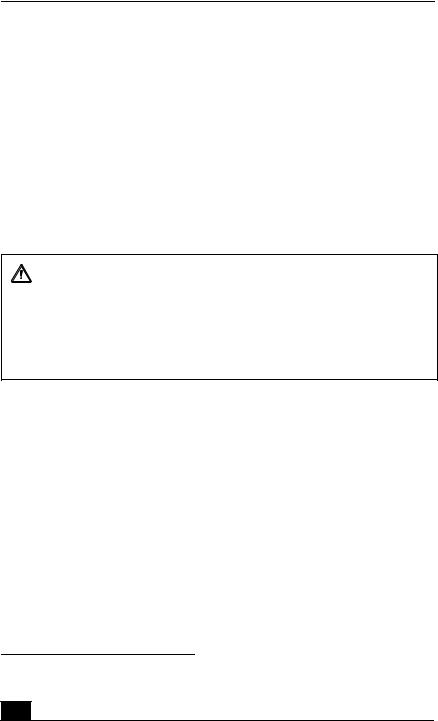
Change text in this variable definition to document title.
To write data to a CD-RW or CD-R disc*
You can use Sony SonicStage and Microsoft® Windows® XP to write data to a CD-R or CD-RW disc. To create a CD-R disc that is readable in a CD-ROM drive, make sure you finish the writing process before ejecting it. For more information, see the instructions included with Windows® XP.
For optimal writing speed, deactivate the screen saver and exit anti-virus software before writing data to a disc.
For best results, use CD-Rs that are compatible with 8x speed.
Do not put your notebook into power saving mode while writing data to a CD-R or CD-RW disc.
Do not strike or shake the notebook while writing data to a disc.
Memory-resident disc utilities, such as the screen saver and virus checker, may cause unstable operation or data loss. Deactivate these utilities before writing data to a disc.
Always use the AC adapter as the power source for your notebook when you are writing data to a CD-R or CD-RW. Using battery power may result in data transfer failure.
* For notebook models equipped with a CD-RW/DVD Combo Drive.
28
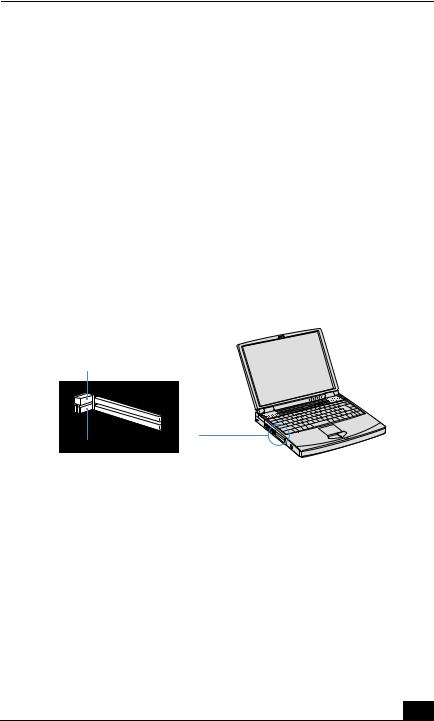
Using PC Cards
Using PC Cards
Your notebook includes two PC Card slots. PC Cards enable you to connect portable external devices such as another hard disk drive, or to connect to a network.
The PC Card slots can accommodate two Type I/II PC Cards, or one Type III PC Card. These slots are compatible with CardBus. Use the lower slot for Type III PC Cards. You do not need to shut down your notebook before inserting or removing a PC Card.
To insert a PC card
1 Push the Release button. The Release button pops out.
PC Card release button
Release button
Release button
29

Change text in this variable definition to document title.
2Press the Release button a second time. The PC Card slot protector pops out.
When you use a Type III PC Card, you need to remove both the top and bottom PC Card slot protectors.
PC Card slot protector
3Insert the PC Card into the PC Card slot.
4Verify that the front label of the PC Card is facing up.
30
